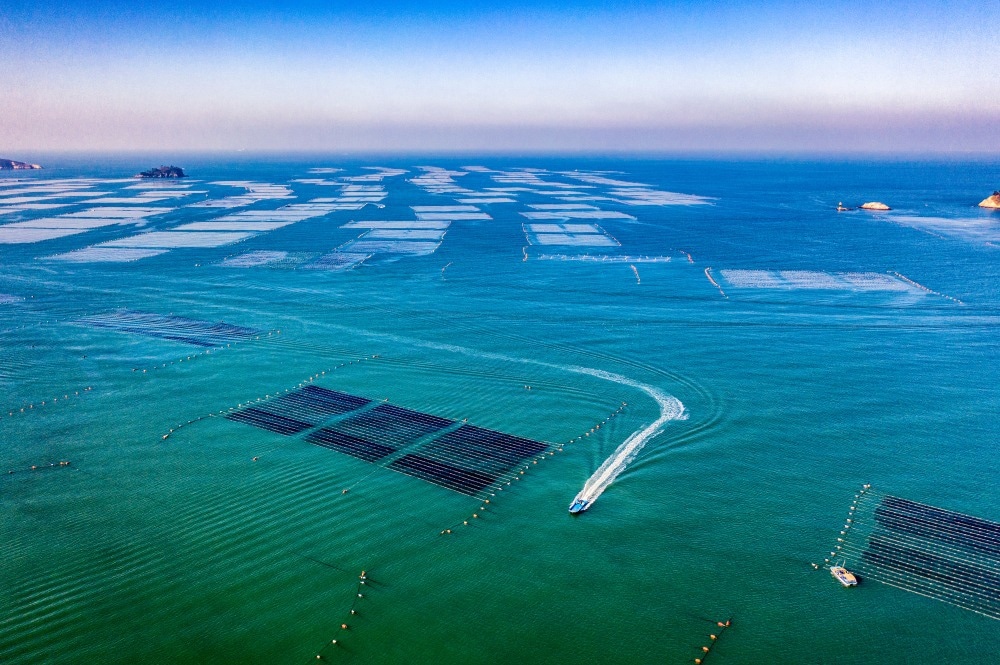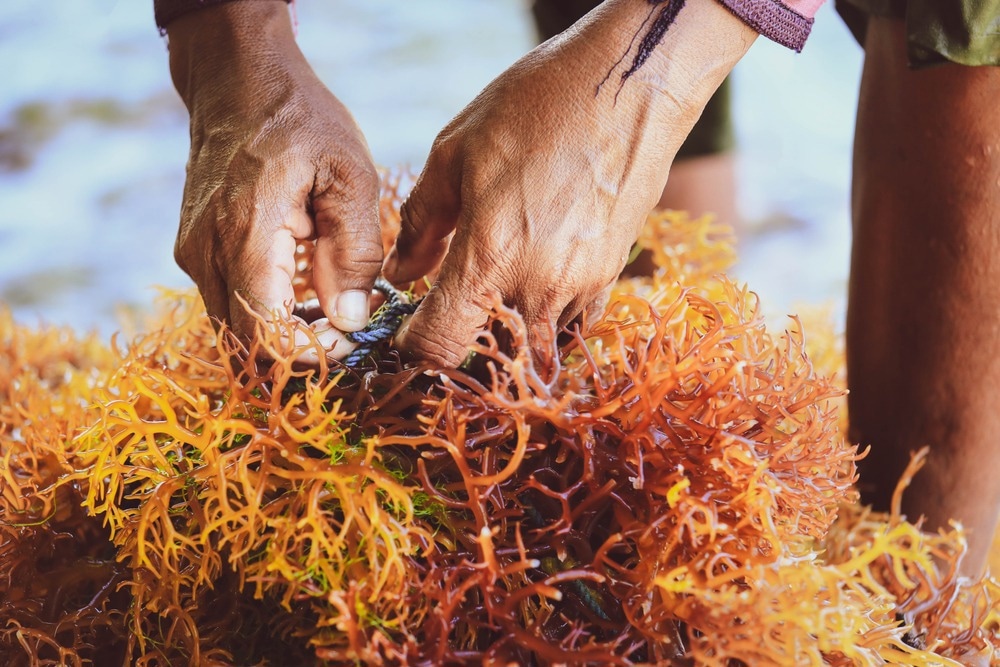Seaweed farming is the most rapidly growing sector in marine aquaculture, with yields more than doubling in the last decade. This is largely due to increasing awareness of the many applications of seaweed and the sustainability of its production. However, if this industry is to be scaled to meet growing demand, bottlenecks in production must first be addressed.

Seaweed farming. Image Credit: Stock for you/Shutterstock.com
The Sustainability of Seaweed Farming
Seaweed farming is viewed as one of the most sustainable methods of food production. This is because seaweed does not require the addition of food, fertilizer, or freshwater for growth and can be cultivated without taking up valuable space for arable land. This form of aquaculture could therefore provide an increasing global population with nutritional, protein-rich food, whilst limiting harm to the planet.
Seaweed cultivation can also benefit the environment by reducing ocean acidification, providing a habitat for a variety of marine animals, and helping to tackle eutrophication through the absorption of nutrients that are dissolved in the sea.
Furthermore, seaweed may help to combat climate change by sequestering atmospheric carbon as it grows. Recent research even suggests that it could play a role in reducing greenhouse gas emissions as, when added to cattle feed, seaweed appears to reduce cattle methane emissions by up to 99%.
As well as its uses as a foodstuff, seaweed has a range of other applications, including in pharmaceuticals, fertilizers, biofuel, and cosmetics. It is due to this wide range of uses, as well as its clear sustainability and environmental benefit, that the size of the global seaweed farming industry has rapidly increased over the last 50 years.
This industry now makes up 27% of total marine aquaculture and is worth over $15 billion annually. The vast majority of global seaweed cultivation is carried out in Asia; however, seaweed aquaculture is now beginning to expand across North and South America as well as Europe, potentially allowing for additional increases in production volume.
Bottlenecks Impeding the Scaling of Seaweed Production
However, despite the clear benefits of seaweed and the recent expansion of the industry, growth in the production of seaweed biomass still trails behind the level of demand for seaweed. This is partly due to various bottlenecks within the process of seaweed production that are currently limiting the scalability of the industry.
The most common method of seaweed cultivation involves attaching small pieces of seaweed to lines of rope or netting, which are then suspended in the sea, usually close to the coast. The seaweed is then harvested either by hand, using a rake, or using a trawler.
As the structures used in these methods are relatively simplistic, they are unable to be deployed too far offshore, where sea conditions are usually rougher. This imposes a limit on the space available for farming and leads to greater competition for space with other land uses, such as fisheries and wind farms, which are often dominant in shallow coastal waters.
Other problems with utilizing areas further out to sea include the additional energy usage and higher cost associated with carrying crops and operators across longer distances during cultivation and harvest. As well as this, nutrient availability in these deeper areas tends to be limited, which can affect seaweed yields.
Seaweed yields are also reduced by pests and diseases, a problem exacerbated when increasing the intensity of seaweed production. Unfortunately, little is known about many of these diseases and as a result, it is difficult to implement effective control strategies against all of them.

Seaweed farming. Image Credit: Eo naya/Shutterstock.com
How can these Problems be Overcome?
To allow seaweed farming to expand into areas further offshore, new technology must be developed that can cope with the harsh conditions in deeper areas of the sea. This could include the use of autonomous buoy systems to protect farms from bigger waves, automated monitoring systems, and drones that allow for the movement of farms to safer areas during storms.
Spatial models could be useful in determining where seaweed farms can share space with other activities closer to shore, such as wind farms, or failing this, help to identify suitable alternative locations.
Limiting the spread of seaweed pests and diseases is also crucial and can be achieved with the help of basic biosecurity measures within seaweed farms. However, to further reduce the incidences and devastation caused by these infections, more research on seaweed disease biology, disease risk factors, and diagnostic techniques will need to be carried out.
Additionally, selective breeding of seaweed species in order to create more disease-tolerant varieties could be beneficial for the long-term prosperity of the industry.
Clearly, solutions to the bottlenecks in seaweed cultivation and harvesting will require considerable time and money to solve. In the meantime, there is still much potential for the growth of seaweed aquaculture despite the current constraints.
For instance, calculations indicate that by 2050, along the Norweigian coast alone, seaweed production could be increased from negligible quantities to around 20 million tons a year, without any improvements to standard production and harvesting practices.
However, this expansion must be conducted sustainably, as growth in seaweed production is currently exceeding the growth of traditional seaweed markets. This is causing seaweed prices to decrease by around 1-2% each year and consequently deterring farmers and investors from getting involved with the industry, which could slow future growth.
Providing monetary compensation to seaweed farmers in return for the role that they play in sequestering atmospheric carbon could help to avoid this issue. This should encourage more individuals to set up seaweed farms and thereby improve the sustainability of the seaweed farming industry in the future.
Sources:
- Ward, G.M., Faisan Jr, J.P., Cottier‐Cook, E.J., Gachon, C., Hurtado, A.Q., Lim, P.E., Matoju, I., Msuya, F.E., Bass, D. and Brodie, J. (2020). A review of reported seaweed diseases and pests in aquaculture in Asia. Journal of the World Aquaculture Society, 51(4), pp.815-828. https://doi.org/10.1111/jwas.12649
- Duarte, C.M., Wu, J., Xiao, X., Bruhn, A. and Krause-Jensen, D. (2017). Can seaweed farming play a role in climate change mitigation and adaptation?. Frontiers in Marine Science, 4, p.100. https://doi.org/10.3389/fmars.2017.00100
- Buschmann, A.H., Camus, C., Infante, J., Neori, A., Israel, Á., Hernández-González, M.C., Pereda, S.V., Gomez-Pinchetti, J.L., Golberg, A., Tadmor-Shalev, N. and Critchley, A.T. (2017). Seaweed production: overview of the global state of exploitation, farming and emerging research activity. European Journal of Phycology, 52(4), pp.391-406. https://doi.org/10.1080/09670262.2017.1365175
- García-Poza, S., Leandro, A., Cotas, C., Cotas, J., Marques, J.C., Pereira, L. and Gonçalves, A.M. (2020). The evolution road of seaweed aquaculture: cultivation technologies and the industry 4.0. International Journal of Environmental Research and Public Health, 17(18), p.6528. https://doi.org/10.3390/ijerph17186528
- Kim, J., Stekoll, M. and Yarish, C. (2019). Opportunities, challenges and future directions of open-water seaweed aquaculture in the United States. Phycologia, 58(5), pp.446-461. https://doi.org/10.1080/00318884.2019.1625611
Further Reading
Last Updated: Sep 21, 2022